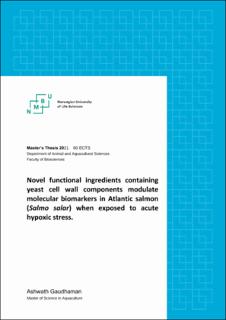| dc.description.abstract | Aquaculture is a continuously expanding global industry, however, some of the major problems associated with intensive fish farming are acute and chronic stressful conditions such as handling, sub-optimal nutrition, transport, diseases, and environmental problems. Stressful conditions can lead to decreased growth and immune response, resulting in compromised fish welfare. In addition, this situation can increase the susceptibility to diseases, causing economic losses in aquaculture. To face this problem, nutrition and the use of functional ingredients could be an alternative to regulate the fish's response to stress conditions. In this study, the short-term stress response (1 min hypoxia) was evaluated in plasma samples of Atlantic salmon fed for nine weeks with a commercial-like diet and two diets with 0.1% of different novel functional ingredients (L4 and L6) derived from non-saccharomyces yeast cell wall. The results showed that cortisol levels were similar between fish from control and L6 group, both groups having a cortisol peak 1h post-stress compared to initial control without stress (NS). A different pattern was seen in the L4 group, with no peak 1h post-stress. Moreover, glucose levels showed significant reduction only in the L4 group at 24h post-stress. There was also a reduction in glutathione peroxidase (Gpx) activity 12h post- stress in the L4 group, which could be due to the absence of increased cortisol in response to stress. Regarding immunological markers, there were no significant differences in the TNF-α levels at different time points among the diets. Nevertheless, compared to NS, an increase of TNF-α was detected at 3, 6 and 24h post-stress, which would suggest an attempt to control immunosuppressive profiles. On the other hand, IL-10 levels were significantly higher in all time points in L6 group. This phenomenon could either be beneficial or detrimental and hence future pathogen challenge trials must be done to validate its effects. A different pattern was detected in L4 group, with no increase in IL-10 compared with the control group. The data from this study propose that fish from L6 group maintained a similar pattern of cortisol response, compared to the fish from control group. On the contrary, the fish from L4 group could prevent the effects related to acute stress, avoiding the increase of cortisol. However, future studies need to be done to identify optimal feeding regime to plan its use in the window of action prior to stressful handling. In conclusion, this study demonstrated that the functional feed containing the L4 non-saccharomyces cell wall component could potentially be used before processes that require the handling of salmon and the feed containing the L6 component gave an indication for improved anti-inflammatory response. | en_US |

